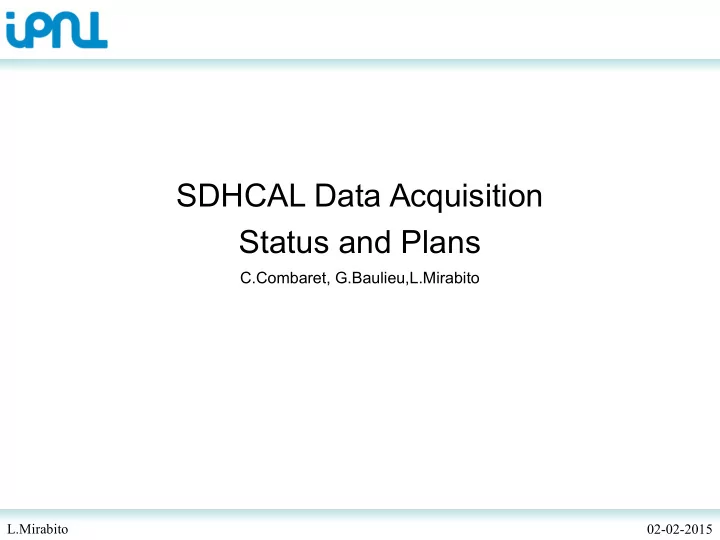

SDHCAL Data Acquisition Status and Plans C.Combaret, G.Baulieu,L.Mirabito L.Mirabito 02-02-2015
Current Status Hardware 50 planes (1m2 each) of GRPC equipped with HR2 chips, inside a stainless steel structure Clock and synchronous commands are sent using HDMI cables between a central SDCC and 7 DCC boards (1 DCC for 8 plane) Three new DIF firmwares: The central DIF of each plane fan in/out clock, command and busy to the 2 lateral ones. Only one HDMI connection per plane Data is readout through USB2 A dedicated mezzanin is plugged on each DIF with USB2 FTDI chips Same firmware and software as with USB1 FTDI chip Software Raspberry pi micro PC equipped with 12-ports homemade USB Hub as Daq frontend 150 usb2 links to 13 Raspberry micro PCs (1 PC for 4 planes) XDAQ not yet supported on Raspberry PI DAQ software migrated to DIM for communication between PCs Possibility to keep XDAQ (or Eudaq) architecture in the backend Same Data structure and DB configuration L.Mirabito 02-02-2015
December 2014 Beam Test Setup Unique HDMI connection per plane Flat cable connection to lateral DIFs 13 RPI with 12-ports USB hub L.Mirabito 02-02-2015
Hardware General View of m3 Trigger Beam Start/Stop SDCC USB RPi DCC 1 DCC for 8 cassettes USB2 (1 spare) USB Boards and asics RPi Hub configurations DIF_G DIF_M DIF_D 1 hub+Rpi for Acquisition data 4 cassettes ASU ASU ASU 6x 24 HR2 ASU ASU ASU USB/USB2 Homemade protocol HDMI medium L.Mirabito 02-02-2015
Software General View of m3 Configuration DB (Oracle) Dif and DIM DB asics conf. Manager DIF Data Handler USB Device DIM DIF DIM DIF DIF Driver Server Client DIF Readout Shm DIM Writer CCC Manager DIM CCC USB Device Online SDCC Server Driver CCC Analysis Archived data Readout Run control Running on DAQ RpIs Running anywhere on DIM the DAQ network interface L.Mirabito 02-02-2015
Plans What is in progress (ILC) Common beam test with other CALICE detectors light(?!) adaptation of software, hardware and firmware to make it compliant with other detectors Main issue is the clock and command compatibility What we plan to build very soon (ILC) A few (4) GRPC detectors (2 or 3 m2) equipped with HR3 chips One (new) DIF per plane Data is readout through TCP/IP links Clock and fast commands are sent to the DIF using dedicated TTC protocol Software still based on DIM What we plan to build very soon (CMS) A few (tbd) GRPC inside leak tights cassettes with TDC/Petiroc electronics Eventually Daq will need to be CMS compliant (GBT use?) and integrate inside the CMS DAQ/Trigger framework Soon, a TTC compliant DAQ is sufficient. L.Mirabito 02-02-2015
TCP/IP +TTC solution Advantages No need of HW implementation, all TCP stack is already implemented in the Wiznet chip TTC protocol well known, many hardware and software implementations already exist TTC hardware well known, many boards already exist and are available (especially at CERN pool) Could be compliant quite easily with m3 prototype (tbc) to be used as tail catcher Current baseline for ILC SDHCAL Disadvantages Require 1 ethernet cable per DIF for data and 1 for TTC TTC technology becomes old Not compliant with CMS upgrade plans L.Mirabito 02-02-2015
GBT solution Advantages : CMS upgrades compliant technology Lighter in term of cables (everything on 2 fibers) More modern technology Disadvantages Requires more expensive hardware (tbc) Designed for CMS -> overkill for ILC in terms of bandwidth Power consumption quite high for ILC (even if LP-GBT exists with <1W dissipation) Both Hardware and Software high quality work has already been performed in the CMS collaboration Ideas Can be used as 1 GBT link per « super module » if someone design a concentrator board to accommodate DIFs Maybe a lighter (slower, lower bw, less consumption) GBT can be imagined between DIFs and concentrator (but is it really neededl?) L.Mirabito 02-02-2015
Summary: What will/could be done? ILC : Develop HR3 system with current baseline (TTC & TCP/IP DIF). -> mandatory to have a technological prototype of SDHCAL with HR3 CMS : Use the new DIF as a GBT experimentation platform to read Petiroc+TDC Otherwise use a Glib board (FMC board to accommodate ASU link required). L.Mirabito 02-02-2015
Recommend
More recommend